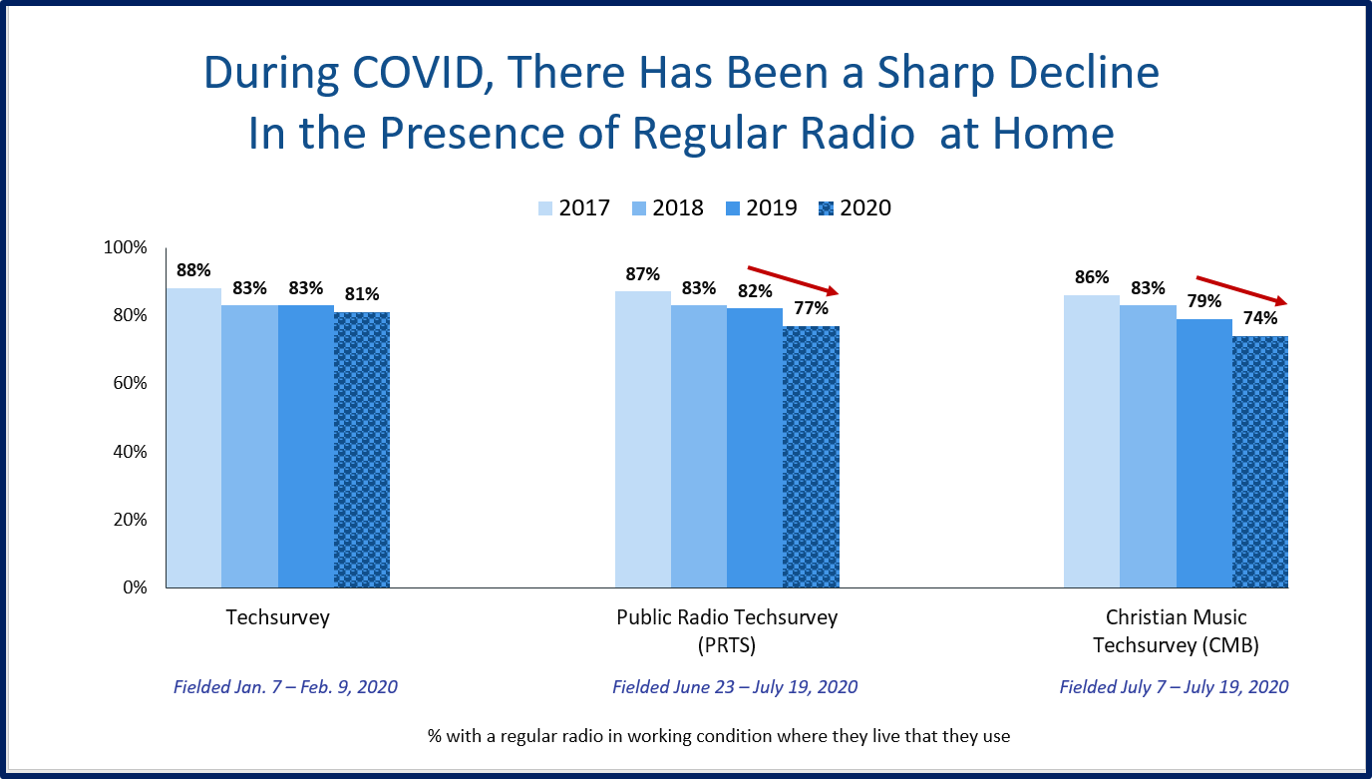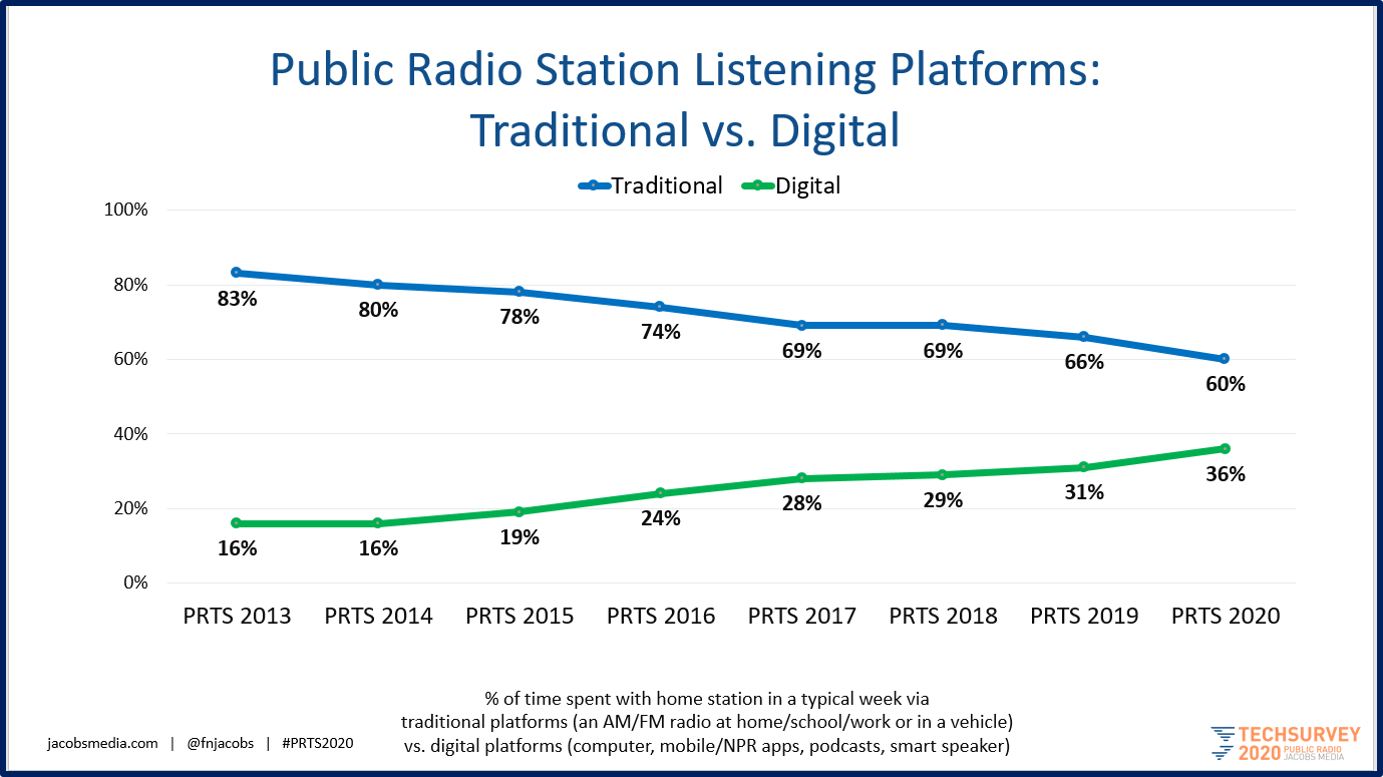(Hypebot) — In this piece, Fred Jacobs looks at the negative impact the pandemic has had on traditional AM/FM broadcast radio listenership, and how broadcasters might be able to turn this struggle into an opportunity.
Guest post by Fred Jacobs of Jacobs Media Strategies
As we’re learning in all too real-time, many fads that were bubbling under in 2019 (or even earlier) have blossomed into full-blown trends since COVID.
Tele-health is one of them. The technology has been in place all along to FaceTime with a physician. It’s just that most people preferred to visit a doctor in person. And truth be told , many medical practitioners aren’t especially adept at conquering new technology.
A story in Forbes back in 2017 made this statement:
“1 in 5 People Would Switch Doctors For Video Visits”
Even three years ago, research was indicating that due to costs, wait time, and other issues, the tele-health concept had a growing appeal.
Consider this: the average in-office visit requires just over two hours (including the commute). According to a Las Vegas medical practice, video visits showed just 5 minutes of wait time, as well as an average of 8-10 minutes actually seeing a doctor.
Fast-forward to the middle of a global pandemic when many people are still hesitant to eat out at a restaurant, much less visit a doctor’s office, and it explains why tele-health is blossoming into a trend.
And so it is with AM/FM radios in people’s home. Pre-COVID, the percentage of “regular radios” in residences has been decreasing steadily over the past few years – like a slow leak.
Until now.
Last week, Edison and Triton released a new cut of their well-known Infinite Dial study, focused on those who listen to various formats (radio stations as well as online sources).
Like our Techsurveys, their research has also been tracking the incidence of “regular radios” in people’s homes. And one of their conclusions from this latest release is that “radio continues to have a hardware challenge, particularly with younger-leaning formats.”
Right they are. We’ve been measuring how format fans differ from one another – including partisans of spoken word stations – for going on a decade. And clearly, there are fewer “regular radios” in homes where Millennials reside.
But it’s gotten even worse since COVID. The last Infinite Dial study was conducted in January/February – the same survey frame we use for our Techsurveys in commercial radio. Looking back on this year, both companies were fortunate to complete their field work before the coronavirus outbreak hit us in North America.
Maybe even a little lucky.
But what impact has the pandemic had on media usage habits these past several months – including the presence of AM/FM radios in people’s homes? So, I checked.
While our Techsurvey, comprised of mostly commercial radio fans, was pre-COVID, our companion studies for both public radio (PRTS) and our Christian music radio studies were both fielded during the summer season – right in the heart of the pandemic.
Here’s what we learned:

In our pre-COVID commercial radio Techsurvey, we see what appears to be a gradual downtrend these past three years.
But in both PRTS and the CMB surveys from the summer, the drop in the presence of AM/FM radios in homes shows a more precipitous decline. And remember who these people are – not just any consumers, but fans of broadcast radio. In public radio, they are primarily donors and sustainers – people who are “all in” to their favorite non-commercial stations.
And make no mistake about it – there is a yin to this yang when it comes to traditional vs. digital media usage. And you can clearly see it in PRTS 2020 (which will be released tomorrow). We will most definitely look back on this year as a moment, a turning point; a seminal year for broadcast radio. Stations that were prepared with well-marketed, quality digital assets in place will have stood the best chance to not just survive – but to thrive during this pivotal moment.
There are two slides in PRTS 2020 that speak volumes about this trend. First, the familiar Media Usage Pyramid. The thumbs-up emojis are everywhere, signaling a rise in so many digital habits and gadgetry. Audio and video streaming, mobile apps, smart speakers, podcasts – all showing nice gains year-to-year.
And the only thumbs-down emoji on the pyramid? AM/FM radio listening (on any device).

Radio’s transition to digital has been in motion for many years now, impacting the industry in myriad ways. But because its effects were often gradual, it has been easy for too many to simply backburner these trends and give them a lower priority. After all, radio still rules in the car, and in many other locations. We may end up looking back at that information as “false positives.”
But COVID has amped up the speed at which digital trends and gadgetry were already moving. We have been tracking how all broadcast radio fans – commercial, public, Christian music – have listened to their favorite stations for many, many years. What is the ratio of listening on “regular radios” at home, work, school, and in the car versus on digital distribution outlets like mobile phones, computers, and smart speakers?
The trend has been unmistakable for several years now – the traditional listening on regular radios line has been a steady downhill slope, while digital consumption’s story gets better every year.
And then there was this summer’s Public Radio Techsurvey 2020:

Once again, the 2020 story’s implications are unmistakable. The coronavirus has accelerated a trend that was already firmly in place.
This has already been a tumultuous year for the public radio system. The news cycle continues to put immense pressure on newsrooms in markets as diverse as New York City, Nashville, and Nome. And work from home has made the environment more challenging and chilling. There have been management shakeups, furloughs, and job losses that have rocked many stations as well. And there is much conversation about the diversity of audiences, employees, and news coverage itself.
We hope that studies like PRTS 2020 (and its predecessors) help the system better understand the impacts of technology and our changing culture on the radio broadcasting industry.
Radio doesn’t just have a “hardware problem.” It has become next to impossible to buy a “regular radio” (unless you buy a car). The little beauty at left retails for $50 at Best Buy, and is representative of the physical radios that consumers can buy, but would much rather purchase sleek new mobile phones, smart speakers and Air Pods.
The digital train hasn’t just left the station – it is picking up speed, fueled by a pandemic is not showing signs of being over just yet. Its lasting effects on radio will be felt for years. There is still time for broadcasters to take advantage of the digital opportunity, and the data can help define those strategies.
Know that we will continue to track it for radio.
Look for our PRTS 2020 deck later this week.
Fred Jacobs founded Jacobs Media in 1983, and quickly became known for the creation of the Classic Rock radio format.
Jacobs Media has consistently walked the walk in the digital space, providing insights and guidance through its well-read national Techsurveys.
In 2008, jacapps was launched – a mobile apps company that has designed and built more than 1,300 apps for both the Apple and Android platforms. In 2013, the DASH Conference was created – a mashup of radio and automotive, designed to foster better understanding of the “connected car” and its impact.
Along with providing the creative and intellectual direction for the company, Fred consults many of Jacobs Media’s commercial and public radio clients, in addition to media brands looking to thrive in the rapidly changing tech environment.
Fred was inducted into the National Radio Hall of Fame in 2018.





























